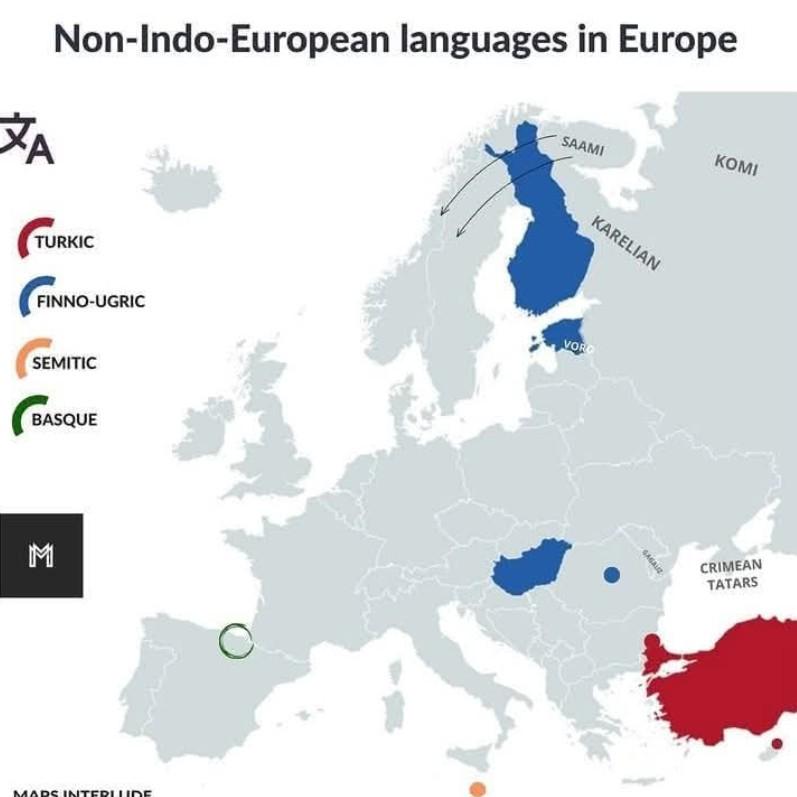Non-Indo-European Languages in Europe Map


David Chen
Data Visualization Specialist
David Chen is an expert in transforming complex geographic datasets into compelling visual narratives. He combines his background in computer science ...
Geographic Analysis
What This Map Shows
The "Non-Indo-European Languages in Europe Map" provides a fascinating look into the linguistic landscape of the continent, highlighting the various languages that do not belong to the Indo-European family. This visualization reveals the geographical distribution of these languages, showcasing regions where languages like Basque, Finnish, Hungarian, and others are spoken. Understanding this map allows us to appreciate the rich tapestry of languages in Europe, many of which have unique origins and histories that set them apart from the more widely spoken Indo-European languages.
Deep Dive into Non-Indo-European Languages
Non-Indo-European languages in Europe represent a significant part of the continent's linguistic diversity. While the majority of languages spoken in Europe belong to the Indo-European family, languages like Basque, Finnish, and Estonian stand out as linguistic anomalies. Ever wondered why Basque is so distinct from its neighbors? It is a language isolate, meaning it has no known relatives, a mystery that has puzzled linguists for decades.
The Basque language, or Euskara, is spoken in the Basque Country, which straddles the border between Spain and France. Interestingly, it is a remnant of the pre-Indo-European languages that existed in Europe, indicating that it may have been spoken in the region long before the arrival of Indo-European languages. This unique status not only makes Basque a subject of academic interest but also a vital part of the cultural identity for the Basque people.
Moving further north, Finnish and Hungarian, both Uralic languages, showcase another branch of non-Indo-European languages. Finnish is primarily spoken in Finland, while Hungarian is the official language of Hungary. These languages share common roots but have evolved separately over thousands of years. Finnish features a complex system of vowel harmony and agglutination, making it quite different from the languages that surround it. Have you noticed that despite being geographically close, Finnish and Hungarian speakers have a completely different linguistic structure than their Indo-European neighbors?
Estonian, another Uralic language, is closely related to Finnish and is spoken in Estonia. The Uralic language family is fascinating because it highlights how languages can develop unique characteristics based on their geographical and cultural contexts. The fact that these languages have survived in a region dominated by Indo-European languages speaks volumes about cultural resilience and identity.
Moreover, languages like Georgian and Azerbaijani belong to the Kartvelian and Turkic families, respectively, and are also included in this category. Georgian, spoken primarily in Georgia, has its own unique script and a rich literary tradition that dates back over a thousand years. Interestingly, its complex grammar and phonetics set it apart from other languages in the region.
Regional Analysis
Examining the map, we can see that non-Indo-European languages are primarily concentrated in specific regions. The Basque language holds its ground in a small area that reflects a strong cultural identity, while Finnish and Estonian dominate northern Europe. In contrast, Hungarian, located in Central Europe, acts as a linguistic island amongst a sea of Indo-European languages.
In the Caucasus region, Georgian stands out as a vital cultural pillar that bridges Eastern Europe and Western Asia, showcasing a blend of influences. Each of these languages contributes to the regional tapestry, creating a mosaic of linguistic diversity that is both intriguing and complex. Interestingly, despite geographical proximity, the differences in language can lead to profound cultural distinctions, as seen in the case of languages spoken in the Balkans compared to the languages in the Baltic region.
Significance and Impact
The significance of understanding non-Indo-European languages extends beyond mere academic interest; it has real-world implications for cultural preservation, identity, and globalization. As Europe becomes increasingly interconnected, the survival of these languages is threatened by dominant Indo-European languages, which often overshadow them in media, education, and commerce. This raises important questions about cultural identity and the need for preservation efforts.
Current trends indicate that many of these languages face challenges, with urbanization and migration leading to language shift and loss. However, there are also revitalization movements aimed at preserving and promoting these unique languages. Efforts in education, media, and cultural initiatives are vital in ensuring that these languages do not fade into obscurity.
In conclusion, the "Non-Indo-European Languages in Europe Map" is more than just a visualization; it is a window into the rich cultural heritage of Europe. By understanding the linguistic diversity represented on this map, we can appreciate the historical narratives and cultural identities that each language embodies. As we look to the future, the preservation of these languages becomes increasingly important, as they represent not only communication tools but also the essence of cultural identity and history in Europe.
Visualization Details
- Published
- August 16, 2025
- Views
- 100
Comments
Loading comments...